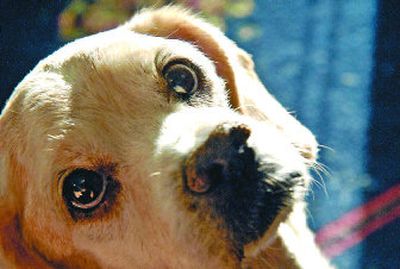Hypothyroidism common in dogs

The thyroid gland, located in the neck, produces thyroid hormone thatregulates metabolism and affects every organ in the body. Millions of Americans must take an oral thyroid supplement each day because of decreased thyroid function. This is thought to be the most common endocrine (hormone) disease in dogs, also. (In cats, hypothyroidism is almost unheard of, whereas increased thyroid function, hyperthyroidism, is extremely common.)
“Primary hypothyroidism” means that the problem is in the thyroid gland itself, not in the parts of the body that regulate the thyroid gland. Primary hypothyroidism accounts for about 95 percent of cases in dogs. Either the thyroid gland is damaged by inflammation (“thyroiditis”), or the gland atrophies and is replaced by fat. Only rarely in dogs is there a tumor causing destruction of the gland.
Any breed of dog can have hypothyroidism, but there are a few breeds with more of a tendency to develop it, including golden retrievers, Doberman pinschers, dachshunds and boxers. Hypothyroidism occurs in all age groups, with most dogs being diagnosed during middle age.
Nearly 90 percent of hypothyroid dogs have some skin abnormality. It may be dramatic with obvious areas of hair thinning or loss, or it may be subtle with just dry, dull-looking fur. About 50 percent of hypothyroid dogs are obese. Often, these dogs are not being overfed, but their metabolism is so slowed down due to lack of thyroid hormone, that they get fat anyway. Other signs you may notice are lethargy and heat-seeking behavior. Your vet may detect neurologic abnormalities, subtle skin or eye lesions, or a slow heart rate. A majority of dogs with hypothyroidism have elevated cholesterol, and about one third are anemic.
Making the diagnosis of hypothyroidism can be a little tricky. The test most commonly performed by labs, often in conjunction with other routine bloodwork, is called a T4. A normal T4 pretty much rules out hypothyroidism, so it is an excellent and inexpensive screening test. If the T4 comes back low, this might mean the dog actually is hypothyroid, but other conditions can cause low T4 as well. Some medications, such as prednisone, anti-seizure medication or certain antibiotics, can decrease T4. Also, dogs sick with other illnesses or chronic conditions naturally have less T4 in the blood. Sighthounds, such as greyhounds and borzois, also have lower T4 levels normally than do other breeds. So, unless your dog has the classic signs of hypothyroidism, your vet may need to run other blood tests such as “free T4,” thyroid stimulating hormone and others to make the diagnosis.
Treatment in dogs, as in people, is oral replacement therapy. Hypothyroid humans generally take a thyroid hormone tablet once daily. Dogs, on the other hand, usually require thyroid hormone tablets twice daily. Also, the dosage, even for a small dog, is always much higher than for an adult human. The reason for this is that dogs absorb the oral dose less efficiently than humans and they metabolize it faster.
Your dog will need to have his T4 checked after starting the hormone replacement to see if any dose adjustments are needed. Usually the T4 is checked just before the next dose is given. Once your dog is on an even keel with the dose, you should see her shed some of those excess pounds. Her energy level should be better, too. The skin problems associated with hypothyroidism may take several months to resolve, but they eventually will.
Hypothyroidism is a common and treatable disease of dogs. Consider asking your vet about testing for it if you are concerned about your dog’s unexplained weight gain, haircoat changes, or decreased energy levels.